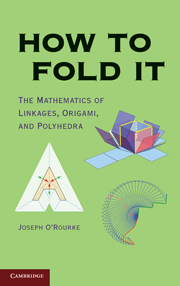9 - Folding Polygons to Convex Polyhedra
Published online by Cambridge University Press: 05 June 2012
Summary
The previous two chapters focused on unfolding the surface of a polyhedron to a net. It may seem that the reverse process – folding – could harbor no more secrets than unfolding. But there is a surprisingly rich structure here, and, as usual, many unresolved questions.
The situation is this. Someone presents you with a polygon cut out of paper, which may or may not be a net for a polyhedron, either an edge-unfolding net or a general net. Your task is to fold it to a polyhedron if possible. Because so little is known about nonconvex polyhedra, we concentrate almost exclusively (until the Above & Beyond section) on convex polyhedra (see p. 105 for the definition), where some deep theorems have been obtained and interesting questions raised. We will see that the richness of folding stems from that surprising fact that a net can often refold to many different different polyhedra, not just the one from which it originally derived.
For those familiar with origami polyhedra folding, that is not what is meant here. Let us stipulate that to fold a polygon to a polyhedron means to make creases that allow the polygon be folded to form the surface of a 3D polyhedron, without any wrapping overlap on the surface and without leaving any gaps. Origami foldings of, for example, a cube have extensive overlap. We want a folding to be the exact inverse of the unfoldings considered in previous chapters.
- Type
- Chapter
- Information
- How to Fold ItThe Mathematics of Linkages, Origami, and Polyhedra, pp. 130 - 141Publisher: Cambridge University PressPrint publication year: 2011

